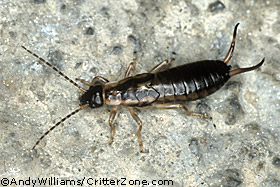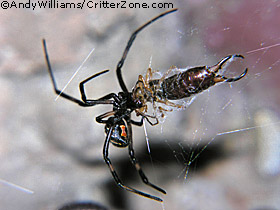| |
|
European earwig, Forficula auricularia,
Earwig, Dermaptera, Euplexoptera
|
| The earwig is so distinct in structure from all other insects that they have their own order. Some appear to have four wings, but the top pair don't cover their entire abdomen and somewhat resemble the elytra (wing covers) of beetles. The second pair are folded underneath the top pair, but when expanded are almost circular in shape and possess veins which radiate from a common center. A pair of forceps-like appendages protrude from the end of the earwig's abdomen and are its most curious feature. These appendages are properly called cerci and look somewhat similar to crawfish pinchers. Earwig cerci can be quite large in relation to the insect, and give it an aggressive appearance. The cerci aren't used as weapons, but they may harmlessly grasp a human hand if handled aggressively. In some winged earwigs they're used to help fold the hind wing. They're also used to assist in mating, male and female grasping each other, or sometimes to grasp prey. |
 European earwig, Forficula auricularia
European earwig, Forficula auricularia
|
| The name earwig is derived from the grossly incorrect old world European belief that these insects seek to enter the ears, or even brains, of human beings. This idea is totally untrue as earwigs are completely harmless. The antiquity of this superstition and the widespread belief in it are evidenced by the fact that these insects have practically the same name in many languages. The Dutch, German, Swedish, Danish, French, Portugese and Spanish all give it a name with practically this same meaning. Our own use of it comes from the Anglo-Saxon term earwicga (ear beetle, worm). A long time ago earwigs were "prescribed" under the doctrine “similia similibus curantur” (like cures like, or hair of the dog). Unfortunate deaf patients were administered more unfortunate insects as a remedy. They were dried, pulverized, mixed with the urine of a rabbit, and poured into the ear! |
| Earwigs have a very broad, omnivorous diet, and feed at night. They eat anything from garden plants, to grass, garbage and other insects. Some gardeners blame them for the destruction of their flowers or veggies, but they're not a major threat to cropland, and generally only a problem for very young, small plants. It has been suggested that in some cases gardeners have blamed earwigs for damage when it was actually perpetrated by other more harmful insects, perhaps even the same ones earwigs prey upon, like aphids. |
 earwig, Dermaptera, Euplexoptera
earwig, Dermaptera, Euplexoptera
|
A curious habit which earwigs possess is that females brood over their eggs. They take the greatest care of the eggs, collecting them when scattered, and moving them from place to place in an attempt to secure the best position for their development. Once the young hatch they are cared for briefly, but soon disperse.
Earwigs can be found throughout the United States, but are more rare in the north as they don't do well outdoors with harsh winter conditions. They're more common in the south. |
 earwig, Dermaptera, Euplexoptera
earwig, Dermaptera, Euplexoptera
|
Earwigs are nocturnal, or active at night, and tend to hide in cracks and crevices during the daylight hours. This is probably where they get into the most trouble with humans, by hiding in our dwelling places and becoming a nuisance to some. However, this same habit may make for a happy black widow spider!
Andy Williams / CritterZone.com |
 earwig being eaten by black widow spider
earwig being eaten by black widow spider
|
The earwig pictures on this page are available for commercial stock photography license. All photos and text that appears on this webpage is copyrighted and may not be copied or used in any way without permission from CritterZone.
CritterZone does not specifically endorse our advertisers, or their methods. We cannot control the ads that run on our articles. CritterZone advocates humane and respectful treatment of all creatures.
Save this page:

|
|
|
|